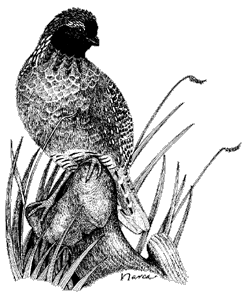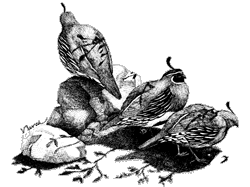Quail
Traveling naturalists, accustomed to the secretive nature of quail in other habitats, are often startled to see how conspicuous Gambelís Quail can be in the Sonoran Desert.
 |
Quail in general are plump birds, rather poor fliers, that spend almost all their time on the ground. Thus they have good reason to make themselves unobtrusive, to avoid drawing the notice of predators. Gambelís Quail are probably no less vulnerable (or tasty) than the other species, yet they behave in ways that call attention to themselves. The males call loudly from low perches; family groups go parading across the flats; coveys of two dozen or more run about clucking in the open. In the sparse plant growth of the desert, it would be impossible for Gambelís Quail to be as secretive as their relatives that live in denser cover, so perhaps shy behavior would be a non-adaptive waste of energy.
At one time, south-central Arizona had another common type of quail: the Masked Bobwhite. Unfortunately, it required not just desert, but lush desert grassland. Large herds of cattle, brought into this region before the principles of range management were well understood, eliminated most of the grasses; when the grass disappeared, so did the Masked Bobwhites. There are still captive flocks, raised from birds found in Sonora, but conservationists have faced major difficulties in trying to reintroduce these birds to the wild.
óKenn KaufmanRepresentative Sonoran Desert species:
Gambelís Quail (Callipepla gambelii)
Masked Bobwhite (Colinus virginianus ridgwayi)
Order: Galliformes
Family: Odontophoridae (New World Quail)
Spanish names: codorniz de Gambel (Gambelís Quail), codorniz comķn (Masked
Bobwhite)
Distinguishing features
Quail are terrestrial birds with short round wings, stout legs with four toes (hind toe is elevated and does not come into contact with the ground), and short, conical bills. The Gambelís Quail has a black top-knot that curves forward; the male only has a black throat, face and belly. Plumage is gray with white, chestnut and buff. The Masked Bobwhite has no top-knot; plumage is brown, black, and buff; the male has a black face and throat with chestnut brown underparts; the female and young have cream colored underparts, face, and throat.
 |
Habitat
Gambelís Quail occur in mesquite habitat, desert scrub, thorn thickets, and riparian areas; often are found in habitats with water nearby. Historical habitat of the Masked Bobwhite was tall grass bordered by mesquite. Before 1880 the masked bobwhite was common in Arizona from the Baboquivari Mountains east to the Santa Cruz valley. Today, it is extinct in Arizona except for a reintroduced population at the Buenos Aires National Wildlife Refuge.
Feeding
ē Diet: Mostly seeds.
ē Behavior: Gambelís Quail are the most arid-adapted quail. During the summer the quail are active early mornings and late afternoons when temperatures are not extreme. They avoid heat stress by resting in the shade during the hottest part of the day. Quail must either drink water daily or obtain it from their food. They can eat insects and succulent fruits of cacti to get this water. Quail also eat seeds and plants. They roost in bushes and low dense trees.
Masked Bobwhite forage in flocks (coveys), except during breeding season; they sometimes move up into shrubs and vines to forage on berries and leaves.
Life History
Quail are gregarious birds. In the fall and winter they often live in coveys of 20 or more individuals, but they pair off during the nesting period. They spend a lot of time on the ground in brushy areas, usually running across hot or open areas to cover. They fly short distances when startled or to avoid predators.
Gambelís Quail usually have 1 brood of 10 to 12 pale-buff eggs. The female incubates the eggs for 21 to 24 days. The nest is a shallow depression lined with grass, leaves, and vegetation; it is on the ground or no more than 10 feet off the ground. All eggs hatch on the same day and the precocial chicks are fully covered with down. They leave the nest soon after hatching, relying on their parents to protect them and to locate food.
Masked Bobwhite were extirpated from the United States due to the destruction of grasslands. Overgrazing and other abuses of southern Arizona resulted in the disappearance of these quail from Arizona during the late 1800s and early 1900s. Attempted reintroductions have not been very successful.